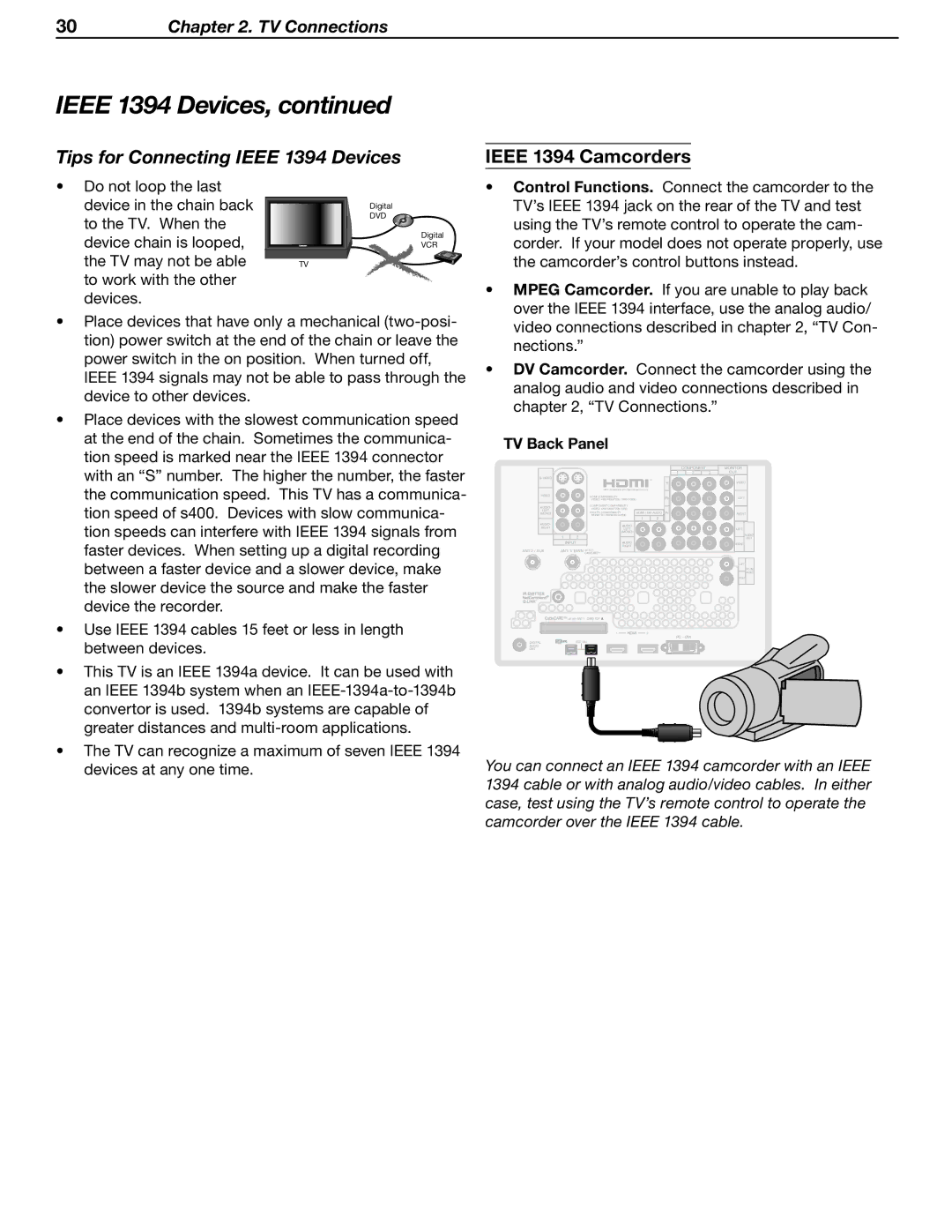
30Chapter 2. TV Connections
IEEE 1394 Devices, continued
Tips for Connecting IEEE 1394 Devices
IEEE 1394 Camcorders
•Do not loop the last device in the chain back to the TV. When the
device chain is looped, |
|
the TV may not be able | �� |
to work with the other |
|
devices. |
|
��������
���� ![]()
�������
����
• Control Functions. Connect the camcorder to the |
TV’s IEEE 1394 jack on the rear of the TV and test |
using the TV’s remote control to operate the cam- |
corder. If your model does not operate properly, use |
the camcorder’s control buttons instead. |
• MPEG Camcorder. If you are unable to play back |
over the IEEE 1394 interface, use the analog audio/ |
• Place devices that have only a mechanical |
tion) power switch at the end of the chain or leave the |
power switch in the on position. When turned off, |
IEEE 1394 signals may not be able to pass through the |
device to other devices. |
• Place devices with the slowest communication speed |
at the end of the chain. Sometimes the communica- |
tion speed is marked near the IEEE 1394 connector |
video connections described in chapter 2, “TV Con- |
nections.” |
• DV Camcorder. Connect the camcorder using the |
analog audio and video connections described in |
chapter 2, “TV Connections.” |
�������������
with an “S” number. The higher the number, the faster |
the communication speed. This TV has a communica- |
tion speed of s400. Devices with slow communica- |
tion speeds can interfere with IEEE 1394 signals from |
faster devices. When setting up a digital recording |
between a faster device and a slower device, make |
the slower device the source and make the faster |
device the recorder. |
• Use IEEE 1394 cables 15 feet or less in length |
between devices. |
• This TV is an IEEE 1394a device. It can be used with |
an IEEE 1394b system when an |
convertor is used. 1394b systems are capable of |
greater distances and |
• The TV can recognize a maximum of seven IEEE 1394 |
������� |
|
|
|
|
|
|
|
|
|
| � |
����� | ������������������ |
|
|
| �� |
| ���������������������������������������� |
|
| ||
|
|
|
| ||
| ����������������������� |
|
|
| |
���������� | ����������������������������� |
|
|
| |
| ���������������������������������������������� | ���������������� | �� | ||
������ | � | � | |||
|
|
|
| ||
����������� |
| ����� |
|
|
|
| ���� |
|
|
| |
|
| ������ |
|
|
|
� | � |
|
|
|
|
����� |
| ����� |
|
|
|
|
| ����� |
|
|
|
����������� ����������� �������� |
|
|
|
| |
| ���������� |
|
|
|
|
������������������������������������� |
|
|
|
| |
| � | ���� | � |
| |
���������������� |
|
|
|
| |
����� |
|
|
|
|
|
��� |
|
|
|
|
|
| ��������� |
| ������� |
� | � | � | ��� |
|
|
| ����� |
|
|
| ���� |
|
|
| ����� |
|
|
| ���� |
|
|
| ����� |
|
|
| ��� |
|
|
| ����� |
|
|
| ���� |
|
|
| ������ |
|
|
| ����� |
|
|
| ����� |
��������
devices at any one time. |
You can connect an IEEE 1394 camcorder with an IEEE 1394 cable or with analog audio/video cables. In either case, test using the TV’s remote control to operate the camcorder over the IEEE 1394 cable.
